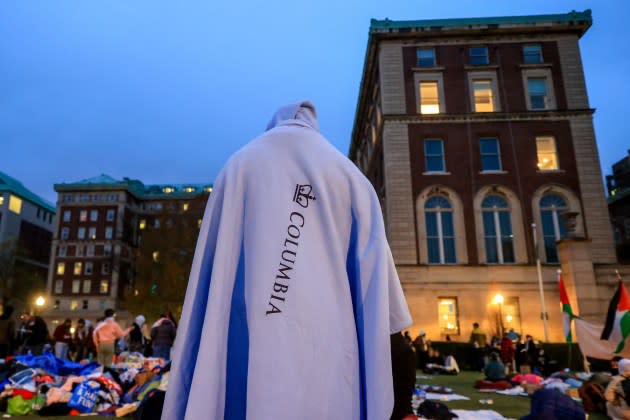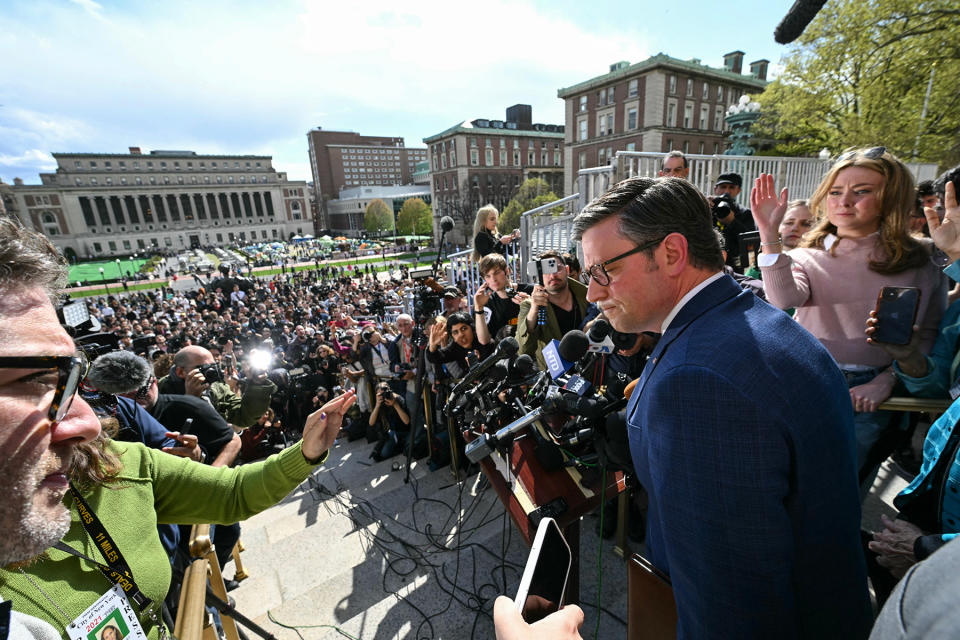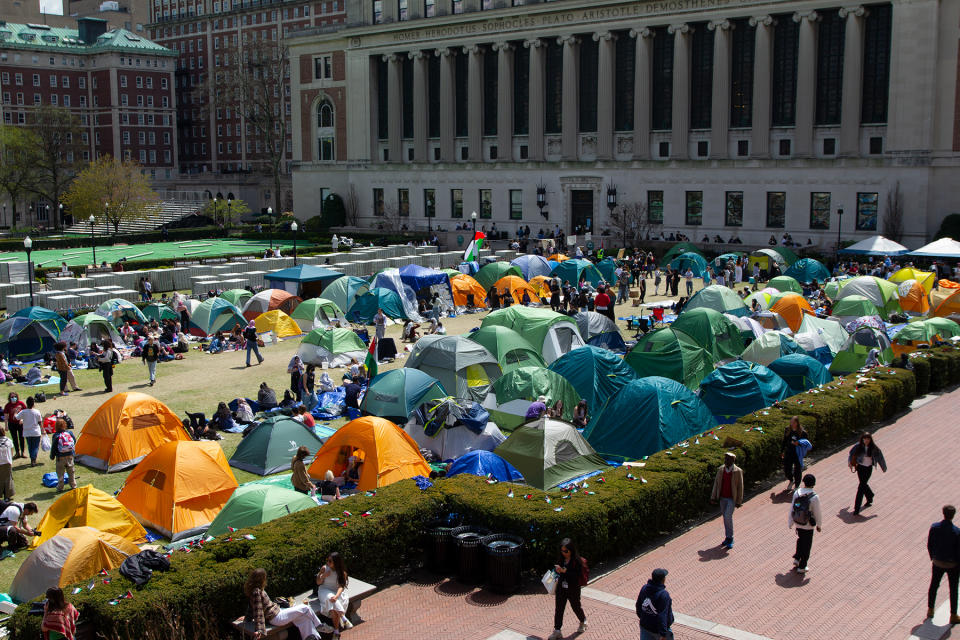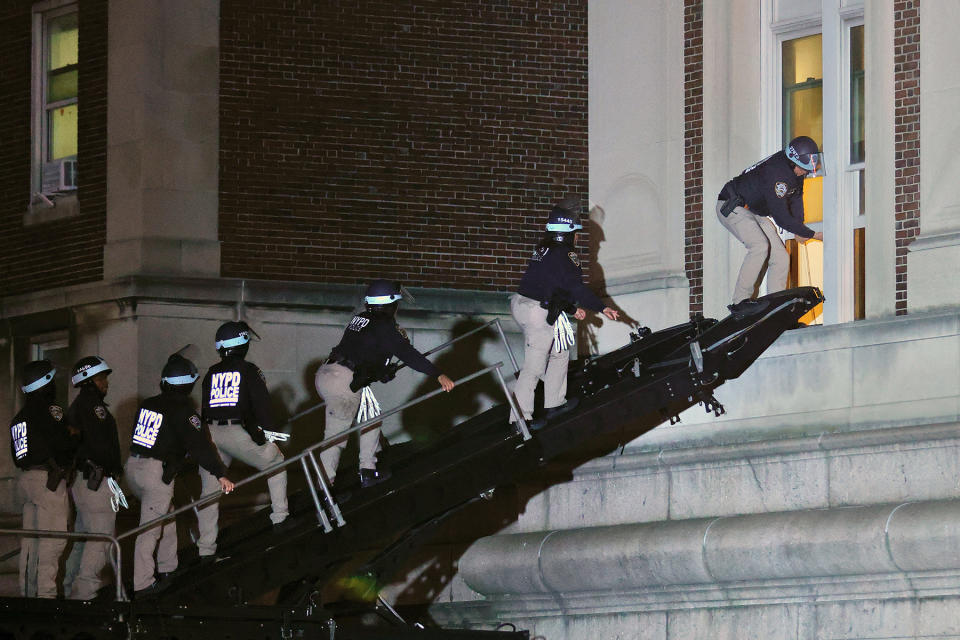[ad_1]

NEW YORK — Linnea Norton spent Sunday at Columbia University jamming on the guitar with other students — a drummer, and a cohort of harmonizing singers. They played Appalachian folk music and protest songs by Bob Dylan and John Lennon. The encampment smelled like sunscreen, and students kicked a soccer ball after a teach-in about imperialism. Some had brought their young children.
A Columbia Ph.D. student, Norton was one of the student activists who were arrested early on in the encampment. She remembered the vote that activists took as they decided whether or not to stay and risk arrest. It was powerful. “I was in a state of anxiety, and like, ‘Ah! What’s happening?’ And then it was like, ‘Oh wow, I remember why I’m here’ — it’s because of Gaza and their connection to their lands,” she said. “And how it’s so important for all oppressed and colonized people throughout the world right now for us to be in solidarity with Gaza.”
Students held the encampment at Columbia for two weeks. They demanded the school divest and sever financial ties with Israel amid its war in Gaza. Israel launched its siege following the deadly Oct. 7 attack by Hamas militants, who killed 1,200 and kidnapped scores of Israelis. More than 34,000 Palestinians have been killed by the Israeli military since the start of the war, millions have been displaced, and half of the population of Gaza is on the brink of famine.
The university initially responded to the encampment with a crackdown. Administrators authorized the entry of the New York Police Department for the first time since the student protests against the Vietnam War in 1968. As their classmates shouted at police officers, 108 students were taken off campus in handcuffs.
The university’s attempts to shut down the initial protest galvanized a larger campus-wide movement. The encampment shifted to the neighboring lawn, where around 100 students spent their first nights sleeping in the open air before filling the lawn with tents.
Last Sunday’s music circle reflected much of the daily life of this encampment. But on Monday, Day 13, the weekend’s scene of normalcy seemed once again to be under threat.
Days of negotiations between students and the administration had reached an impasse. The protesters were not going to budge on their core demands: disclosure of the university’s investments in Israel, divestment from those funds and companies, and amnesty for students suspended after the NYPD first arrested protesters. Columbia, too, was firm in its response: “The university will not divest from Israel,” an 8 a.m. email from University President Minouche Shafik announced on Monday.
Around 9:30 a.m., a group of university administrators marched across campus to deliver the news: Students in the encampment would have until 2:00 p.m. to sign a set of forms identifying themselves and evacuate the camp. If they didn’t, they faced suspension and ineligibility to complete the semester.
Administrators waited at the entrance for the signed forms. Most protesters were still asleep. At 10 a.m., as students began to rouse and news of the 2 p.m. deadline spread, the camp began to erupt in chants. Students from across the university gathered outside the encampment. Many of them joined in the chants.
“There’s definitely a fair amount of stress in the air because we don’t really know what’s going to happen, because we just received those slips this morning that seem very threatening, very intimidating,” Cameron Jones told Rolling Stone shortly before the 2:00 p.m. deadline. “But I’m sure that we have a mass mobilization of students that will be able to hold the camp and keep energy high.”
Most students remained in the camp through the 2:00 p.m. deadline. Two hours later, they began to receive word of their suspensions.
Norton initially wasn’t sure whether or not to sign the administration’s form. “It just feels like a really big decision. Cause, on one hand, I really wanna be able to get back into buildings and get back into my lab,” Norton said Monday. “But also, I made a commitment to be here and to be in solidarity with my students — but ultimately with Gaza, of course. That’s why we’re here.”
IN THE TWO WEEKS after the first tents were pitched, the Columbia encampment became a major focal point of media and political attention, and contention.
Between regular protests that congregated outside the campus gates, journalists and media swarmed the south lawns during the afternoons. In their coverage, news outlets and politicians depicted rampant antisemitism on Columbia’s campus, perpetuated by privileged students wasting their parents’ money.
Lawmakers berated President Shafik in a congressional hearing on April 17, shortly after student protesters set up the encampment. On April 24, House Speaker Mike Johnson (R-La.) and other Republican lawmakers visited Columbia for a press conference, where Johnson accused student activists in the encampment of being violent and antisemitic.


“Things have gotten so out of control that the school’s canceled in-person classes. And now they’ve come up with this hybrid model where they will discriminate against Jewish students,” Johnson said. “They’re not allowed to come to class anymore for fear of their lives. And it’s a testament as Columbia has allowed these lawless agitators and radicals to take over.”
A few days later, two New York lawmakers, Mike Lawler (R) and Ritchie Torres (D), announced they would introduce the College Oversight and Legal Updates Mandating Bias Investigations and Accountability Act, or the COLUMBIA Act, a bill that would allow the Department of Education to place a “third-party antisemitism monitor” at universities.
In a Monday press briefing, Joe Biden’s press secretary, Karine Jean-Pierre, said that the president “has always been clear that while Americans have the right to peacefully protest — that’s something that we believe here in this administration — he stands squarely against any violent rhetoric,” adding that “there is no place for antisemitism on campuses or anywhere else.”
Some Jewish students on campus did describe witnessing antisemitism. “I went to the antisemitism task force hearing Sunday [April 21] afternoon, and I sat for two hours and listened to a lot of my friends, my Jewish friends, and a lot of other people who I know telling stories about how they’d been intimidated, stalked, verbally assaulted, verbally harassed, physically assaulted, like actual stories of that,” said Robbie Fox, a senior at Columbia.
On the evening of April 20, a photo went viral of an individual holding a sign that read “Al-Quds next target” next to a group of counter-protesters waving Israeli flags. Last week, a video of one of the encampment leaders resurfaced. In the clip, filmed during a January disciplinary hearing, the student said “Zionists don’t deserve to live.” The organizer was banned from campus that Friday, according to a university statement sent to the Columbia Spectator.
In response, the encampment leadership said that the student’s “words in January do not reflect his views, our values, nor the encampment’s community agreements,” adding: “We are students with a right to learn and grow. In the same way some of us were once Zionists and are now anti-Zionists, we believe unlearning is always possible and that no human being is static.”
From the ground, these instances of antisemitism were far outside the norm — the encampment was peaceful, and included many Jewish protesters. Jewish encampment leaders, including members of Jewish Voice for Peace, led Seder services and celebrated Passover.
That didn’t silence critics, or alter the outside media narratives. After a press conference last Friday, Fabiola, an undergraduate student activist, took questions from reporters. One woman — who claimed to be an independent journalist and appeared to be live streaming on her Instagram — asked Fabiola whether she was tokenizing Jewish students by supporting Jewish Voice for Peace, the anti-Zionist protest group. Members of the encampment’s de-escalation team took Fabiola aside and asked if she was OK. After a few moments, she returned to interviewing. The woman continued to lurk around, still filming.
To counter misrepresentations, the organizers created a system where only “media-trained” campers would be able to talk to the press. When reporters entered the camp, they had to agree to guidelines — which included not photographing faces without permission — and stay in the designated media corner. There, media-trained students could approach.
Many of the encampment activists were Jewish. Norton, for instance, said her paternal grandfather is a Holocaust survivor. (Her maternal grandparents are survivors of the Armenian genocide.)
Some Jewish supporters of the encampment said they have faced online threats. Jon Ben-Menachem, a fourth-year Ph.D. sociology student, says he experienced doxing as a protester. “I gave up on masking or protecting myself because it’s already out there,” he said.
Ben-Menachem spoke of his Judaism being called into question, too. “I’m receiving tons of hate mail accusing me of basically being a race traitor,” he said. “And what I can say is that Zionists are constantly moving the goal posts for who is allowed to speak about Israel.”
For Ben-Menachem, the most significant threat to Jewish students came from the administration’s initial crackdown — not the claims of antisemitism that have pervaded recent coverage. “The biggest threat to Jewish safety on campus is the arrests that happened last week,” he said. “We’re terrified that there’ll be another Kent State or Jackson State at Columbia.”
Low-income and international students faced additional risks — from harassment, to issues with their visa status and family relationships.
Khanh, an encampment organizer and undergraduate student, spoke of the ties she felt as a first-generation Vietnamese immigrant with the Palestinian cause. Khanh, who supports her single mother, was acutely aware of the importance that an Ivy-league education held for her family.
“Columbia’s education, or at least this idea of education and social mobility, is very meaningful to my family. Coming from a low-income background, all of the things that Columbia promises [about] getting a good job after graduation, the eliteness, and the prestige, it could mean a lot. It could break a lot of generational barriers for me,” she said.
Even so, Khanh said, “I feel very proud of my decision and I am standing with it, with conviction. We have shown time and time again how strong we are. They can try to sweep us again, but we’re prepared.”
One protester, an international graduate student who declined to share identifying information, said the encampment made her feel safe again. In the fall, she experienced two traumatizing incidents of harassment and racial profiling. Groups of men followed her for several blocks home and, in one case, accused her of being a member of Hamas or ISIS, she said.
“This is the first time that I feel my community,” the protester said in the later days of the encampment. “As unsafe as it is to be here, it’s the only place on campus where I feel safe.”
AROUND MIDNIGHT LAST WEEK, as a police helicopter loomed above the encampment and chants of “free Palestine” drifted in from the street, several hundred Columbia students gathered in small, hushed groups across the central campus lawn.
Students self-organized according to the consequences they were willing to face. Yellow armbands meant they were willing to be suspended. Red meant they were preparing for arrest. “You will not be sentenced to life in prison,” an encampment organizer assured the students who clustered around him. “Your earrings will be taken from you, your jewelry will be taken from you. You will be searched, very thoroughly.” The students wearing red armbands listened intently.
Minutes before, students had received a campus-wide email from the university president, Shafik, warning that if discussions with organizers and faculty were not successful, the administration would “consider alternative options for clearing the West Lawn and restoring calm to campus so that students can complete the term and graduate.”
Shortly after midnight, organizers announced to the campers that the negotiations had received an extension until 8:00 a.m. that morning. Students re-pitched their tents, hastily cleared minutes earlier, and prepared for an early wake-up. After that, the encampment returned to a state of daily normalcy. Teach-ins and sign-painting resumed. A “People’s University Library” appeared inside a tent, tended to by an encampment librarian.
Meanwhile, negotiators from the encampment and the university continued to meet. University representatives proposed half-measures: scholarships for Palestinians, a Columbia offshoot in Haifa to match the planned Tel Aviv Campus, and limited amnesty for some students. Student negotiators were not persuaded.
Over the weekend, with negotiations at an apparent impasse — and the May 15 commencement looming — rumors of an encampment escalation, in the form of a planned building takeover, reached the university.


The next day, the administration presented protesters with an ultimatum: Students could stay in the encampment and be suspended, or abandon their tents, confess their identities to administrators, and accept the lesser punishment of probation through June 2025.
Leading up to the new deadline, dozens of faculty members arrived at the encampment in support. They wore bright orange vests and stood together in front of the camp, arms linked.
At night, despite fears of a police raid, the encampment protesters remained. But later that evening, a call went out to the Columbia community: “MOBILIZE TO THE ENCAMPMENT NOW.”
Shortly after midnight on April 30, many students began to disperse from the encampment. Some gathered at the sundial in the middle of campus, where they sang and chanted “Minouche Shafik, your can’t hide, you’re supporting genocide.” Others began to move tents up to a new lawn on the northeast side of campus in front of Lewisohn Hall.
Dozens of students headed to Hamilton Hall — the building that protesters took over during the Vietnam War in 1968. Protesters were already inside. One had opened the doors by smashing the glass and reaching through to open the door.
From the outside, supporters used heavy tables, chairs, and trash cans to barricade the entrance. Inside, students wedged chairs against the doors.
Energy ran high as people cheered on the occupiers. They began hanging signs and Palestinian flags out of windows. From the top floor, students dropped a long, vertical banner that read “INTIFADA” in red. Others hitched “Student Intifada” onto the side of the building. Finally, the students put up a sign that read “Hind’s Hall” — named after a young child who had been killed by the Israeli military. Students sitting on ledges of the building a couple stories up led chants and songs for hours afterwards.
The encampment was much quieter and emptier Tuesday after a busy night. In the chilly morning, there were still students in front of the front and back entrances to Hamilton Hall, bundled up in blankets and huddled together.
Norton had joined in the protests the night before. “I just heard people starting to cheer and then I looked up and they had gone to the top floor of Hamilton, turned the light on, and we saw them waving to us in the windows,” she said. “And it was just so powerful.”
She said she decided against signing the administration’s form, saying it would have “felt like betraying myself and betraying our movement.”
Norton said she is instead working with a Columbia student workers union lawyer to push back against the administration. At this point, she doesn’t know how it will affect her academic career and research. But she remains committed to the movement.
“I’m confident that I’m in the right, and I would rather have things take longer and be true to my values and just objective truth than betray those things just to get back to the labs,” she said.
SHORTLY AFTER 9:00 P.M. on Tuesday — the 56th anniversary of the NYPD campus raid to arrest Vietnam War protesters at Columbia in 1968 — the police once again entered the Columbia grounds.
Hundreds of officers flooded the campus, and marched towards Hamilton Hall. Student protesters held their ground as they confidently sang, “We shall not be moved,” and locked arms. Police cornered press away from the front of Hamilton Hall. Shortly afterwards, the NYPD Emergency Service Unit unit arrived with equipment to forcefully enter the building.


University President Shafik had once again authorized the NYPD to enter campus and clear Hamilton Hall. In her letter to the police, Shafik said the protesters had left her with “no choice” but to request the police’s return to campus that night — and requested their presence through May 17, two days after Columbia’s scheduled graduation ceremony.
“We believe that while the group who broke into the building includes students, it is led by individuals who are not affiliated with the university,” Shafik claimed in the letter.
The police were rough Tuesday night. They shoved student observers and protesters out of the way, focusing their force on the students still locked in arms at the entrances of the building. According to the NYPD, 119 protesters were arrested that night.
“It is going to take time to heal, but I know we can do that together,” Shafik said in a statement Wednesday afternoon. “I hope that we can use the weeks ahead to restore calm, allow students to complete their academic work, and honor their achievements at Commencement.”
Through Tuesday night, Norton waited outside Central Booking in downtown Manhattan for the arrival of the arrested protesters. She had not been on campus at the time of the raid — but she planned to wait there until her fellow protesters arrived.
On Wednesday afternoon, Norton texted that she was still at the station with a friend: “We’re both unable to stop until we know our comrades are OK.”
“I’ll think of [my time at Columbia] as a turbulent time, for sure,” said one student. “I started school with the pandemic. I ended it with this. But I think the huge majority of peaceful resistance has been inspiring, and I think that’s what I’ll remember from this era. And I think I’ll remember this crackdown as a fascist, authoritarian move.”
More from Rolling Stone
Best of Rolling Stone
[ad_2]
Source link